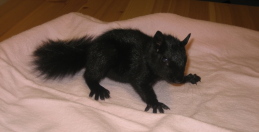CARE FOR
ORPHANED SQUIRRELS
http://www.orphanedwildlifecare.com/squirrelcare.htm
|
CONTENTS DETERMINING THE SPECIES OF SQUIRREL IS
THIS SQUIRREL TRULY ORPHANED? THE
FIRST ORDER OF BUSINESS: WARM THE BABY THE
SECOND ORDER OF BUSINESS: CHECK FOR INJURIES ATTEMPTING
TO REUNITE WITH THE MOTHER IF THE BABY IS AN ORPHAN THAT NEEDS TO REMAIN IN CARE, READ ON BABY
SQUIRRELS NEED TO BE RAISED WITH OTHER BABY SQUIRRELS INITIAL
FEEDINGS NEED TO BE REHYDRATION SOLUTION USE
AN ORAL FEEDING SYRINGE NOT THE SMALL PET NURSING BOTTLES ELONGATED FEEDING
NIPPLES SHOULD BE PUSHED ONTO THE END OF THE 3CC SYRINGE FORMULA FOR ORPHANED BABY
SQUIRRELS HOW MUCH TO FEED
IS BASED ON THE BABY SQUIRREL’S BODY WEIGHT HOW OFTEN TO FEED WILL DEPEND ON THE SQUIRREL’S AGE BATHROOM
BUSINESS #1: FLUIDS IN THE TOP, OUT THE BOTTOM FIRST
HOUSING – BIRTH TO ABOUT 5 WEEKS INTERMEDIATE
HOUSING – 5 WEEKS TO ABOUT 8 WEEKS PRE-RELEASE
CAGING – 8 WEEKS TO ABOUT 12 WEEKS PRE-RELEASE CAGING NEEDS PROTECTION FROM PREDATORS RELEASE
WHERE THEY WERE HOUSED IN THEIR PRE-RELEASE CAGE THEY
WILL BE BONDED TO PERSON AND PLACE CHARTS: DETERMINING THE SPECIES OF SQUIRREL
IS THIS SQUIRREL TRULY ORPHANED?
When people find young squirrels, whether tiny eyes-closed infants or slightly older eyes-open (but un-weaned) babies, it is usually due to one of 5 scenarios:
Obviously the first scenario means the young are orphaned and in immediate, often desperate need. Eyes-closed infants will be dehydrated and starving, usually having waited for their mother for a day or more before wiggling out of the nest. Slightly older eyes-open babies often approach and follow people, even climbing up a pant leg. Baby squirrels rely on their mother for a long time, weaning gradually after about 8 weeks and remaining with mother until 12 weeks of age, so a fluffy little 6 week old, eyes-open baby, although mobile, is still totally dependent.
In the second and third (but only occasionally fourth and fifth) scenarios, the young may still be reunited with their mother, so long as they are not injured (unless the injury is superficial). One thing to note is that eyes-open babies who have been missing their mother for only hours rather than days (i.e., mom is still nearby) may be more wary than in the first scenario, and not as likely to approach people, because they will not yet be so desperate.
The reason the fourth and fifth scenarios only occasionally lead to a reunion with the mother is that predators are often attracted to unguarded nests of babies, where the mother has already gone missing, or predation itself has caused an injury, and an injured baby should not be returned to its mother.
CAUTION about “creating” orphans: Squirrels choose warm protected places to have their young, sometimes in and around our dwellings. Baby squirrels are often “created” orphans when homeowners hire pest control companies to remove the mother. The best solution for the homeowner and the babies is to leave the mother squirrel alone for a grace period of a few weeks – she will move her young herself once they become mobile and start to venture out of the nest. At that point it is safe to exclude the entire family and make repairs so the situation does not repeat. If you have found very young babies (with scant or no fur and eyes closed) and their birth nest has been destroyed or the mother barred entry to it, she may not be able to take the babies elsewhere. She may not have another nest site safe and warm enough to keep such fragile infants alive. Therefore if this is the case, if at all possible, try to restore the birth nest in hopes the mother will be able to continue to care for the babies there. Older, mobile and fully furred youngsters are hardier, and the mother is more likely to have an alternate nest site that will suffice for them in an emergency – and she will often choose to move older babies if the birth nest is threatened.
NOTE: If the mother is still there, she will take her young back, given the opportunity, even if you have touched them. She will pick them up one at a time and carry them off to safety providing she has a safe and warm enough den site to take them to.
READ ON TO FIND OUT HOW TO DO THIS PROPERLY
THE FIRST ORDER OF BUSINESS: WARM THE BABY
THE SECOND ORDER OF BUSINESS: CHECK FOR INJURIES
1. In a safe spot, with good light – in a small washroom for example, unwrap the baby and check it all over for injuries. It is handy to have a few more clean cloths and a basin of warm water and a washcloth (white is best so you can see any blood) to clean away dirt from a suspected injury. At this stage, it is important for an adult to carefully assess the squirrel in a quiet room without children or pets present. The washcloth should be wrung out in warm water and then made to mimic the mother gently licking the baby clean – all over. Try to use a light cloth like those used for human babies so that you can feel the orphan through the cloth. Go slowly and take your time, and this will calm the baby and make your examination easier.
2. When cleaning the baby, please pay special attention to the face, checking for dried blood in the nose, and mouth, to make sure it can breathe easily. Also pay attention to the genital area – try to see if the baby pees when gently stimulated with the soft warm cloth or a Q-tip or tissue, and note the colour of the urine. On males stimulate the penis – a small nub about ½” above the anus; on females stimulate the little nub very near the anus. Stimulate for a full minute or two, using light feathery strokes.
ATTEMPTING TO REUNITE WITH THE MOTHER
The squirrel is NOT a candidate for attempting to reunite with mom if it:
If you believe the mother is still around, and you attempt to return the young to her, please be patient and very vigilant. Put them as close as possible to where you found them or where you know the nest to be (mom will not know to look anywhere else), and monitor carefully from a distance or from inside a building. Do not cover them with any materials, or even put them in an open box, they need to be left out exposed in plain view so the mother can see them or she will not find them. However, this is a balancing act, because they also need to be kept safe and warm. Place them in a little depression created by bunching a thick soft cloth into a saucer-like nest, and put this improvised nest on top of a hot water bottle (that you refill every few hours). If you add a couple of pop bottles filled with hot water beside the hot water bottle and wrap it all in an old wool sweater, the heat will last longer. Remember, mother squirrels do not seem to recognize a baby as their own if its body temperature is not normal. The mother may come, and check, and then leave only to come back in several hours for them. She may be off preparing a new nest for them or simply anxious, cautious and scared. She can pick up and move only one baby at a time, so sometimes the process will take hours. Please do not leave them unmonitored, or out after dark since mom is active only during daylight, and they will be vulnerable to predation, especially after dark. If the mother has taken one or more of the babies bring the rest in once it gets dark for overnight care, and try again early the next morning. You can try a third day also, but after that it is unlikely the mother is still around.
IF THE BABY IS AN ORPHAN THAT NEEDS TO REMAIN IN CARE, READ ONWhen a wild baby loses its mother it is in desperate trouble. Its best chance for survival will be for a rescuer like you to find a wildlife rehabilitator. Wildlife rehabilitators are community volunteers, often licensed by government wildlife agencies, and they will know how to raise your rescued baby so that it is releasable back into the wild. They will buddy it up with other orphans of its species and provide expert care. Your search for a wildlife rehabilitator may take you several hours and many phone calls, but try not to give up – they are usually unpaid volunteers and there are not nearly enough of them to provide this service in all areas or for all orphans. Try calling local humane societies, animal rescue groups, vet clinics and pet stores for contact information in your area, or try searching the Internet by typing in “wildlife rehabilitation” or “wildlife rehabilitator” and your location.
If you need to care for the baby while you are searching for a wildlife rehabilitator, or if you are unable, despite your best efforts, to find one in your area, please read this entire article now before beginning the care. It will help you avoid simple mistakes that are easy to make, and could result in injury or death to the baby and heartache for you. It’s a good idea to also print it out, so it’s handy to check details as questions arise when you are caring for the baby.
BABY SQUIRRELS NEED TO BE RAISED WITH OTHER BABY SQUIRRELS
If you determine that the squirrel is orphaned, it will have littermates that also need help so please continue to check the area frequently for a week or more. If no siblings are found contact local humane societies, animal rescue groups, vet clinics and pet stores to try to find a baby squirrel buddy. Please make every effort to search out a buddy. Young squirrels readily accept other baby squirrels, even if their ages are not exactly matched. Baby squirrels raised with other baby squirrels bond to each other, learn from each other, and rely on each other for warmth, play and companionship not only during rehabilitation but after release as well. Please understand that it is vitally important to the squirrel's proper socialization and eventual release into the wild that it be raised with other squirrels. It must learn the social “etiquette”, the “language” of being a squirrel. A baby squirrel raised alone without other baby squirrels has a greatly reduced chance of a successful release.
Note: When you are raising several baby squirrels, and they all look alike, it may be hard for you to keep track of who is who when feeding them. One solution is to carefully trim the last little bit of fur from the tip of their tails in various ways, using manicure scissors. For example – leave one baby with an untrimmed tail tip; trim one off in a square “brush cut”; for another trim only half of the tip, leaving a long thin tuft, etc.
SQUIRRELS DO NOT MAKE PETS
Please think ahead and focus on the fact that in a couple of months the small baby you have rescued will need to be set free into the wide world. Squirrels do not make pets. Once they are no longer babies, they are extremely active and independent – and yes, if their natural independence is thwarted they will bite the hand that feeds them. Spend a few minutes watching the acrobatics of your neighbourhood squirrels and think about the deprivation of a life in a cage or a house for such a wild animal.
If it proves impossible to find a buddy, make every effort to raise a single orphan (as you would a group of orphans) so that it retains a healthy fear of dogs and cats and other humans. When it is released its very life will depend on such natural wariness.
On the other hand, a single orphan will bond to you as its mother substitute because like other species of mammals, a baby squirrel’s psychological well being depends on the feeling of security it will get from loving attentive care. Thus you will need to handle, cuddle and play with it, to provide comfort and some of the tactile stimulation it will miss from not having a mother or siblings to sleep and play with every day. Interaction with other people should be minimal - the ideal being that only one person ever handles it. Give it toys in its cage to stimulate play. Parrot toys can be hung in the cage, or human baby rattles and small stuffed toys are good, or create your own toys using thick rope, pinecones, small branches, bark, limestone pieces, empty toilet paper rolls, empty tissue boxes etc.
Except for the times when you interact with it, keep the squirrel confined safely to a cage in a room out of high traffic human activity. Do not treat it like a pet, in the sense of getting it used to free run inside the house, or habituating it to species it should fear (such as cats and dogs) since this will increase the likelihood it will get into serious trouble with other people or pets once it is released.
INITIAL FEEDINGS NEED TO BE REHYDRATION SOLUTION
Orphans that have been without their mother will be suffering from chill and dehydration. They must be thoroughly warmed first, and then, although they are starving, they must be given warmed rehydration solution before any milk formula is offered. Their dehydrated little body is simply unable to digest food (i.e. the milk solids in formula) and if given formula or other food before they are rehydrated it can kill them, or cause debilitating diarrhea. Pedialyte is a rehydration solution made for human babies, and is available in drug stores – it often comes fruit flavoured, but if you can find the unflavoured kind that is best for wildlife babies. It should be heated to body temperature and offered frequently: every 30 minutes to babies that will take only a small amount, or every 2 hours to those that take a larger amount. Feed only Pedialyte for the first several feedings – as much as the baby wants until it is rehydrated and producing lots of light yellow urine when you stimulate it. Stimulate it at each feeding using light feathery strokes.
In an emergency, a homemade rehydration solution can be made by mixing: ½ teaspoon salt + ½ tablespoon of sugar + 2 cups of water – warm slightly to dissolve sugar and salt. Use this homemade solution only until you can get to a drug store. Pedialyte is a balanced electrolyte solution, much better for the baby. Once Pedialyte is open refrigerate between feedings, and discard any unused portion after 72 hours. It can be frozen in an ice cube tray and the cubes stored in the freezer for use within a couple of months.
USE AN ORAL FEEDING SYRINGE NOT THE SMALL PET NURSING BOTTLES AVAILABLE AT PET STORES
It is critical for YOU to control the flow of fluids, and with the little pet nursing bottles you cannot do that – nor will the baby squirrel be able to nurse from them anyway. The short stubby nipples on these little bottles seem to look “right” to our eyes but they are next to useless for feeding baby squirrels. Please use an oral feeding syringe instead, and practice with it by expressing liquid into a cup to see how it feels to control the flow. At first it is best to start with a very small 1cc or 3cc feeding syringe. You can find these at a vet clinic or drug store – ask for the o-ring syringes rather than the single use ones which will stick after only a few uses. Get a few 10cc o-ring syringes also because later when both you and the baby squirrel are more experienced you can graduate to that size (see photos of feeding tools).
For the first few feedings when the baby is debilitated or desperately hungry it may be difficult to establish a smooth, gentle feeding regime. The baby may be frantic and want to suck the fluids too quickly (risking inhaling fluid into its lungs, which must be avoided), or quite weak and need you to slowly drip small amounts of rehydration fluid into its mouth.
ELONGATED FEEDING NIPPLES SHOULD BE PUSHED ONTO THE END OF THE 3CC SYRINGE
PetAg makes “elongated” feeding nipples that work very well for feeding baby squirrels. They do fit the little pet nursing bottles, but please use them instead pushed onto the end of a 1cc or 3cc oral feeding syringe. You can find them in some pet stores. They come “blind” – without a hole in the end. Make every effort to create a very small hole. Pierce the nipple with a darning needle and then boil it and cool it with the needle still inserted. If the resulting hole is too small do this again with a larger needle or toothpick. If the hole is a little to large, it will shrink slightly if you soak the nipple in boiling water again briefly. Or, you can use manicure scissors to cut off as little of the tip as you can to create a very small hole. The aim is for flow of liquid to be slow and natural, and to prevent the baby squirrel from sucking fluids too fast. Practice with it by expressing the fluid into a cup before trying to feed the baby. A hole that is good for rehydration solution may need to be a tiny bit bigger for milk formula since formula will be thicker. Medical Supply stores stock little plastic adaptors, or tips (at the end of this article there is a link to an online source) that will fit a 10cc syringe so that it will hold an elongated nipple – for later on when you and the baby are more experienced (see photos of feeding tools).. These nipples look long, but you will be surprised that your baby squirrel (even a small baby red squirrel) will suck most of the elongated tip into its mouths. Seat the nipple up against the roof of its mouth so its tongue has room to move comfortably. For the first few feedings you will have to encourage the baby to take the nipple into its mouth, but most learn quickly, and suck well from them.
FORMULA FOR ORPHANED BABY SQUIRRELS
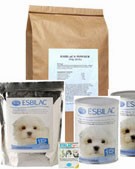
Readily Available Option: PetAg makes a puppy milk replacement formula called Esbilac, which should be available at local vet clinics or pet stores. Some stores might carry another type of puppy milk replacement formula that can be used if you can’t get Esbilac as long as it has the same ingredients as Esbilac. Do not be put off by the fact that it is called a puppy milk replacer as it can also be used for baby squirrels. Get the powdered product rather than the liquid, and keep it refrigerated after opening. Never use human baby formulas, cow’s milk, goat’s milk, soymilk, and most other pet products as they are not suitable and will likely cause severe diarrhea/dehydration, malnutrition or death for the baby, and a great deal of heartache for you. Likewise, the homemade receipes for wildlife formulas that are posted to the Internet are often referred to as ‘death formulas’ by experienced wildlife rehabilitators, so please do not use them. Again – your baby squirrel’s life depends on you getting the right formula – if you get the wrong formula, both the baby and you will undoubtedly suffer. Gradual introduction of formula, following rehydration: After the baby has had several feedings of rehydration solution, introduce the milk formula gradually using the following 4 steps:
One easy way to do this is to draw up one syringe of milk formula (reconstituted according to the directions below) and express it into a coffee mug, then draw up 3 syringes of Pedialyte and express that into the mug. Mix and then feed with that solution, warmed to body temperature, for the first introduction of formula feeding…..and so on. Some wildlife rehabilitators advise using plain water instead of Pedialyte to dilute formula in this 4 step gradual introduction. Important mixing instructions for PetAg formula (Esbilac): See www.ewildagain.org for detailed information on mixing Esbilac. PetAg changed the manufacturing process for Esbilac in 2008, resulting in a powder that does not dissolve as readily – the powder particles apparently have a hard ‘shell’. So, it is important to follow these mixing directions carefully. The milk powder must be dissolved fully for your baby squirrel to be able to digest it.
Formula should be kept a bit warmer than body temperature during the entire feeding since it cools down quickly once drawn into the syringe. Some baby squirrels are very sensitive and will refuse to take it if the temperature is not right. Formula in a coffee mug can be set in a larger container of hot water to keep it warm during the feeding session. Put a small cloth over the cup holding the formula so it stays warm. If you order the Fox Valley formula (see below), once it arrives it is a good idea to gradually change over from the Esbilac you have been feeding: Mix 3 parts Esbilac with 1 part Fox Valley for a few feedings, then mix the formulas half and half for another few feedings, then 1 part Esbilac with 3 parts Fox Valley for another few feedings, and then go to full strength Fox Valley. Because Fox Valley formula is made specifically for baby squirrels you will no longer need to add any cream, but you may continue to add yoghurt or probiotics if you wish.
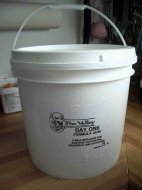 Another Option but it must be Ordered: Fox Valley Animal Nutrition makes milk replacement formulas specifically for wild orphans, including baby squirrels. If you are going to be doing care for more than a few days, then you should order this formula as the baby squirrels will definitely benefit from it. It is available online at: http://foxvalleynutrition.com or call 800-679-4666 (in the U.S.) or 815-385-6404 (outside the U.S.) You will save on the cost of formula by ordering it because pet store prices are usually higher. There are two Fox Valley formulas for baby squirrels: 32/40 (for eyes-closed orphans) and 20/50 (for older eyes-open orphans). Some wildlife rehabilitators order both but some simply use the 32/40 for all baby squirrels up until the time they are weaned to solid foods.
HOW MUCH TO FEED IS BASED ON THE BABY SQUIRREL’S BODY WEIGHT
Make every effort to weigh baby squirrels in grams so you will know how much formula to feed them. Many people have kitchen scales that will weigh in grams, or postal scales, and certainly vet clinics would be able to weigh your baby squirrel for you. An underfed little one will be deprived of enough calories to thrive or sometimes even survive, whereas overfeeding can lead to a host of problems, including digestive upset, diarrhea, bloat, and in some cases, death. Carefully measuring the amount of formula your baby squirrel should take at each feeding will also give you insight into whether it is doing well or not. If its appetite is poor, or it obviously wants much more than you calculate it should have, please take it to a veterinarian for an assessment. Keeping a record of its weight gain over the weeks of formula feeding will help you feel assured that it is gaining appropriately.
A good rule of thumb is to feed eyes-closed baby squirrels 5% of body weight at every feeding, with eyes-open babies sometimes wanting between 5% and 7% of body weight at each meal. If the baby is weighed in grams, to calculate number of cc (1cc = 1ml) of formula per feeding, simply divide the weight by 100 and multiply by 5 to get 5%, and by 7 to get 7%.
Examples of formula amounts for each feeding, calculated at 5 - 7% of body weight:
Eastern grey baby squirrel: 20 gram baby (eyes-closed): 1cc per feeding 40 gram baby (eyes-closed): 2cc per feeding 80 gram baby (eyes-closed): 4cc per feeding 100 gram baby: 5 – 7cc per feeding 200 gram baby: 10 – 14cc per feeding
Red baby squirrel: 10 gram baby (eyes-closed): 0.5cc per feeding 20 gram baby (eyes-closed): 1cc per feeding 40 gram baby (eyes-closed): 2cc per feeding 60 gram baby: 3 – 4.2cc per feeding 80 gram baby: 4 – 5.6cc per feeding
Once feeding is well established and your baby squirrel is doing well, especially after its eyes are open, it may want more formula than the 5% rule dictates, so you can be a little flexible at that point – going to 7%. It is safer to slightly underfeed than to overfeed. After a feeding, a baby should be comfortable, with a little plump tummy, soft and round, not a tight, bloated or distended abdomen. Overeating is usually not too much of a problem with healthy baby squirrels that have settled into care and are doing well. Nevertheless, they are all individuals and there are certainly exceptions to this, so considering the problems overfeeding can cause, it is always best to continue measuring the formula at each feeding. If you can’t get a gram weight, use the chart at the end of this article to estimate weight.
If your baby squirrel is not taking the amount of formula you calculate it needs:
HOW OFTEN TO FEED WILL DEPEND ON THE SQUIRREL’S AGE
When you first rescue a baby squirrel, apart from whether its eyes are open or not (eyes-closed infants will be less than 4 weeks old, eyes-open babies will be more than 4 weeks old), a look inside its mouth will help you determine age. If the baby has no teeth or only the bottom two front teeth are present, it is very young since the bottom incisors are the first to erupt at about 3 weeks of age. The top two incisors (front teeth) erupt next, between 4 and 6 weeks of age and the cheek teeth appear at about 6 weeks of age. Note: because a squirrel’s teeth are ever-growing, they must align correctly in order to wear down continually. When a baby falls it sometimes hits its face and if there is facial swelling the growing teeth can be pushed out of alignment leading to a “malocclusion”. Please be vigilant in checking your baby squirrel’s teeth on an ongoing basis, to make sure they are growing straight, and wearing down evenly. You can sooth swollen gums by cleaning around the teeth after each feeding, using a Q-tip dipped in warm saline solution. If the swelling is judged to present a significant risk of causing a malocclusion some wildlife rehabilitators advise treating right away with a course of antibiotics.
The development chart below will help you decide how old your baby squirrel is. Number of formula feedings per day decreases while amounts fed at each feeding increase as the baby gets older. There is a geographic difference in size for Eastern grey squirrels in North America. Body mass increases as you go further north, so young born in the north will likely be bigger on average than those born further south – although features of each age (for example time when eyes open, or teeth erupt) will be the same. The chart below uses weight data based on the experience of wildlife rehabilitators at the northern edge of Eastern grey squirrel habitat. Weights for young at the same stage of development will vary not only between individuals but across regions as well. Therefore it is best to decide how much formula to feed based on individual weights using the chart below as a general guide only.
At the end of this article you will find a link to a site maintained by a Connecticut wildlife rehabilitator with pictures of Eastern grey baby squirrels from newborn to release age posted, to help you determine how old your orphan is. There are also other links, to help you identify whether you have an Eastern grey or Red baby squirrel – red babies are smaller and have a dark stripe on their nose.
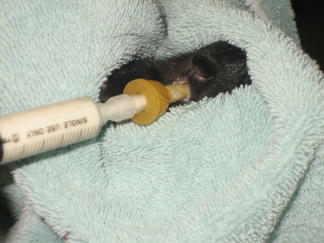 As mentioned above, choose a quiet room with no distractions. Hold the baby squirrel in an upright position (not on its back) wrapped snugly and firmly in a soft cloth or towel, covering its eyes. Keeping the baby wrapped in a towel not only gives you more control when feeding but the squirrel will feel more secure, much like nursing from mom in a quiet, dark nest. Once the baby gets used to this method, it will be less anxious and distracted by sights and sounds as it gets older and is harder to handle when being fed. Allow it to push against or hold the end of the syringe with its forepaws.
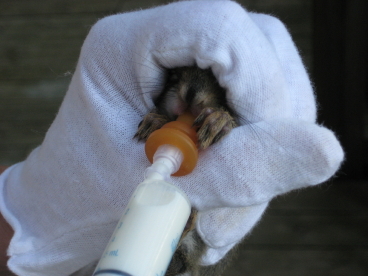 Note: if you are caring for red squirrel babies they may be extremely bonky, wiggly and even nippy once their eyes are open at 4 weeks. Try wearing light little cotton gloves to pick them up with and hold them for feedings, covering their eyes over with your index finger. Allow the gloves to retain their scent between feedings by not washing them too often. Scent is extremely important to baby squirrels, and their own scent is reassuring to them. Make sure the room you feed in is secure, in case a baby gets away from you during feedings. A hungry baby squirrel can suck very quickly and take too much formula if you are not in total control. If this happens it will bubble formula out of its nose. Immediately stop feeding, lower the baby’s head to allow formula to run out of the nose, and gently wipe the excess formula from its nose. Repeat this for about 5 minutes or until the nose is clear and breathing returns to normal. If this aspiration problem is severe and fluids get into the lungs, it can cause immediate death or pneumonia on a longer-term basis. That is why it is so important for you to control the flow of fluids for the baby – and also why the smaller size syringes are safer, in that the baby cannot get so much formula all at once from a 1cc or 3cc syringe as it can from a 10cc one. Take your time, and go slowly, carefully watching both the squirrel and the syringe. If air bubbles appear in the syringe it is an indication the baby is sucking fluid more quickly than you are depressing the syringe plunger. If the baby is doing fine and just wants the formula a little faster, then try to accommodate, (perhaps even going to a larger syringe), but if it is bubbling formula from its nose, stop feeding, and expel the air from the syringe before continuing. When you resume feeding if the baby continues to suck too strongly, try to hold the syringe plunger back a bit rather than depressing it. You should also fit a new elongated nipple to the syringe – one with a smaller hole.
Some baby squirrels go into a sort of “nursing trance” when they are intent on sucking and their tongue seems to adhere to the roof of their mouth – they will look almost like they are gaping, with mouth wide open – but will continue to swallow the drops of formula you keep providing from the syringe. This can be a little disconcerting though, so if you wish, you can wake the baby from this by stopping for a minute and washing its face before starting to feed again.
Note: After every feeding thoroughly wash the baby squirrel’s face, neck and under its chin with a warm washcloth. Formula dries like glue and turns hard, sticking the fur to the skin, which must be very uncomfortable, and results in fur loss. In nature the mother squirrel would lick her babies clean all over many times a day.
BATHROOM BUSINESS #1: FLUIDS IN THE TOP, OUT THE BOTTOM
It is critical that baby squirrels are stimulated to urinate at every feeding. They may be peeing a bit on their own, but this can simply be overflow from a distended bladder, and if they are not stimulated the bladder can rupture. Inside their nest they do not pee on their own, the mother squirrel licks away the urine and thus keeps the nest clean. To stimulate a baby squirrel hold it over a face cloth, and dip your finger, a Q-tip or tissue in warm water and then light feathery strokes over its genital area will cause the baby to urinate and/or defecate. On males stimulate the penis - a small nub about ½” above the anus; on females stimulate the little nub right near the anus. Once the squirrel starts to pee don't stop stroking until it is finished or it will stop without finishing emptying its bladder.
Note: Young babies love to suck. Sometimes baby squirrels will suck on each other’s ears or other parts of their bodies, and when that body part is another baby’s penis, the penis can become red and swollen – sometimes, in extreme cases developing a scab and creating a situation where the sucked-on baby can no longer urinate. If this happens you will need to separate the babies until they are a little older and this need to suckle lessens. Soak the sore penis in warm water for 15-20 minutes until the scab slides off easily. Then cover the penis with an antibiotic cream such as Polysporin to soothe the swollen tissue. If the baby still cannot pee however, please take it to a veterinarian for an assessment. Try feeding baby squirrels that are sucking on each other smaller amounts more frequently – to help satisfy their sucking instinct.
The first stool you see from a rescued orphan will usually be dark in colour, but once the baby is digesting milk formula the stool should be firm little mustard coloured pellets. Overfeeding can cause stool to be pasty and paler in colour. If the baby has loose stools or diarrhea dilute the formula half and half with plain water for a few feedings and try to feed smaller amounts more frequently. Work back up to full strength formula gradually as the problem resolves.
Overfeeding and other digestive upset can also lead to bloat. Bloat can sometimes be relieved by massaging the abdomen while holding the baby with the bottom half of its body submerged in a basin of warm water. Sometimes a few drops of a human pediatric colic medicine (symethicone) will help relieve bloat in a baby squirrel, and sometimes a small dose of stool softener (such as lactulose syrup or docusate sodium “Colace”) will help. Do not feed the baby formula if it is bloated, offer Pedialyte instead, and if your best efforts do not resolve the problem within a day, please take the baby to a veterinarian for an assessment. Digestive upset is often a feeding problem (wrong or too much formula, or formula feeding before the baby is fully rehydrated), but occasionally it results from intestinal parasites or a coccidia infection, and your vet will be able to treat for these conditions.
FIRST HOUSING – BIRTH TO ABOUT 5 WEEKS
Housing requirements change as baby squirrels grow and develop. Keep very young eyes-closed orphans in a warm room away from drafts and noise in a small enclosed box with breathing holes. Create a cozy nest with several layers of soft cloth, flannel or polar fleece bedding. Make sure this bedding has no holes and is non-ravelling since wiggly little animals can quickly become strangled in hanging threads. Avoid using terry cloth towelling for very young or weak babies because their claws are easily snagged and stuck in the fabric loops – which can result in twisted limbs. Change the bedding twice a day and launder it without using fabric softener or softening sheets in the dryer since these leave scents that are hard on the babies’ respiratory system. Likewise, wood chips release aromatic oils, and are thus not good to use for bedding, nor do they provide insulation and warmth in a nest.
Provide external heat by setting the box half-on, half-off a heating pad covered with a towel, and set to low, or put a hot water bottle well-wrapped in a soft cloth in the box beside the babies so they can snuggle against it. Make sure there is enough room in the box for them to wiggle away from the hot water bottle (or to the part of the box not on the heating pad) if they get too hot. Cover them over, head and all, with soft cloths. Refill the hot water bottle at every other feeding (or when it is no longer warm enough) and also check that it is not too warm for them and does not leak. Some wildlife rehabilitators use a “rice sock” instead of a hot water bottle – made by half-filling a cotton sock with dry uncooked rice, tying the top, and then heating it in the microwave for a few minutes, reheating it at every feeding.
Note: If you are caring for red squirrel babies, they are escape wizards, especially once their eyes open. Therefore, if you have more than two babies, it is a good idea to have two housing set-ups until they are weaned. At feedings you are then able to pick up each baby, feed it and transfer it to the other housing. This will help you avoid escapes and also allow you to easily keep track of who is fed. 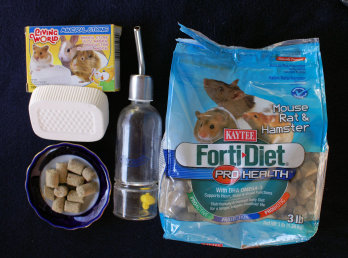 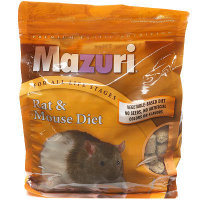
Note: It is very important baby squirrels learn to eat rodent block (which is a large pellet, usually about 1” x ½ inch), since it will provide 100% nutrition while they are in captivity. After their eyes open, put a few pieces of rodent block in the nest. If they “teethe” on it as their first solid food, they will get to like it – otherwise it is a tough sell since it’s not as tasty as the other solids they will be offered once they are weaned. Choose a rodent block made for rats and mice - not one for gerbils or hamsters. Keep it refrigerated in a tightly sealed container after opening to preserve freshness. Please do not buy the bags of mixed seed/grain also labelled for rats and mice or even those labelled “squirrel feed” as an alternative to rodent block since your youngsters will then just pick and choose and eat only the tasty bits – getting nowhere near 100% nutrition. Caged squirrels are susceptible to “metabolic bone disease” if their diet is not complete, so this is a very important consideration. Check local pet stores; there are several brands of rodent block made for rats and mice – “Mazuri” and “Kaytee” are two good ones. At the end of this article you will also find links to sites to order rodent block on-line.
INTERMEDIATE HOUSING – 5 WEEKS TO ABOUT 8 WEEKS
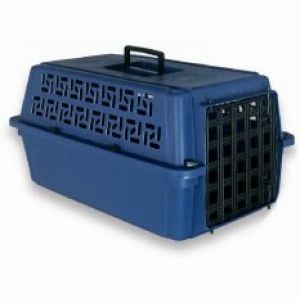
Baby squirrels become more mobile after their eyes open. Housing should still be kept in a quiet warm room, but you will now need to provide them with more space to play and exercise – for example a large dog-size pet carrier (26”x15”x17”high) with a towel in the bottom and enough space for their hanging water bottle and food at the front and more soft bedding at the back for them to hide in and sleep under. This arrangement will give them a feeling of security – i.e. similar to a tree cavity or leaf nest that is enclosed and safe. If the front wire door of the pet carrier has mesh that is too big, and the babies could get their heads stuck in it or even escape through it, cut a piece of window screening and securely attach that over the door.
Start to remove their supplemental heat source gradually at this point, (except with single babies or those that are not well) starting with a few hours a day – removing their night heat last. Heat can be provided by placing the back corner of the pet carrier on a heating pad covered with a towel, and set to low – this provides gentle continuous warmth to their sleeping area.
Continue to provide rodent block and add two new elements to their housing at this point: 1) a drinking water bottle 2) a small mammal mineral stone
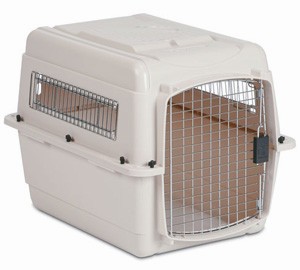
A week or so later, when the squirrels are about 6 weeks old, after you notice they are chewing the rodent block you should add other teething materials, such as twigs and small branches with buds and leaves. This will allow for gnawing to keep their ever-growing teeth worn down and healthy. Replace chewed branches and twigs daily. Be careful to provide such natural objects from areas that have not been sprayed with pesticides. Also add a few large striped unsalted sunflower seeds to the dish of rodent block and a separate dish of chopped fruit such as apple, banana, grape, avocado, and melon. At first it is a good idea to also peel the grapes since young squirrels tend to choke on the skins. This is most certainly a messy stage, and you will need to change their bedding and clean their carrier daily.
PRE-RELEASE CAGING – 8 WEEKS TO ABOUT 12 WEEKS
After baby squirrels are weaned (or nearly weaned at about 8 weeks of age) they need to spend 4 weeks in a large pre-release cage before being released at about 12 – 13 weeks of age. The cage should be as large as you can manage, but at least 2ft x 4ft and 4ft high (this size fits through most doorways), and made of 1” welded wire mesh for grey squirrels, and ½” mesh for red squirrels (red babies are smaller and can escape through 1” mesh). Do not use “chicken wire” because it is much too light and squirrels can gnaw through it or get their heads stuck. Put a large piece of plywood on the inside floor of the cage to place their dishes on so that food does not fall through the wire. Hang an old sheet around the back and sides of the cage to increase their feeling of security.
Furnish the cage with a secure wooden nesting box (greys: 10” x 12”; reds: 10” x 10”), constructed with a “predator baffle” since it will later be their release box. The nest box can be fixed to an upper corner of the cage by pushing pieces of 1” or ½” wood doweling through the wire mesh to hold it in place (see photos). Other pieces of doweling can also be pushed through the mesh, or natural branches fastened inside the cage, to create climbing opportunities that mimic the branches of a tree. Please be creative – the youngsters will love fresh branches with buds and leaves, replenished daily (maple is a favourite for greys, and reds like cedar and pine also) and as many natural elements as you can gather - such as stones/pebbles, pieces of bark, flower seed heads, maple seed keys, acorns, pinecones and mosses. Give them a little clean straw or dried grass in their box as bedding, and allow them to use the fresh leaves you give them to also line their nest - a better and more natural alternative to cloth bedding. Check the box every couple of days to make sure it is staying dry, and clean it if necessary – you do not want any mould inside their box. Put a big hardwood stump or large log of hardwood in the bottom of the cage and watch how much energy the youngsters will expend working on it. Be careful to provide such natural objects from areas that have not been sprayed with pesticides.
This is a very messy stage so the cage should be cleaned daily. Place a plastic tarpaulin under the cage with an old sheet on top which will catch the debris, and wash the sheet once or twice a week.
Juvenile squirrels are extremely active and this four week period allows them to exercise, grow strong, and practice the skills they will need once they are released. By the time they are 12 weeks of age, and ready for release, they should be about ¾ of their adult size.
PRE-RELEASE CAGING NEEDS PROTECTION FROM PREDATORS
The pre-release cage should not be placed outdoors since it needs protection from predators. Caged squirrels panic when a predator such as a raccoon or a cat comes near or climbs on the cage, and even though protected by the wire mesh, they can die of stress or injuries from claws through the wire. They do not feel secure in a cage outside amid all the sights and sounds because they know they are in something from which they cannot escape. It is therefore important to place the cage in a secure shed or garage, leaving the doors and windows open during the day when someone is around to closely monitor the situation, but securely locking it up each evening before dark. This way the squirrels can adjust to outdoor temperatures and sounds but feel and remain secure. An old sheet draped around the back and sides of the cage will give them a further sense of security – like being in a secluded tree nest.
RELEASE WHERE THEY WERE HOUSED IN THEIR PRE-RELEASE CAGE THEY WILL BE BONDED TO PERSON AND PLACE 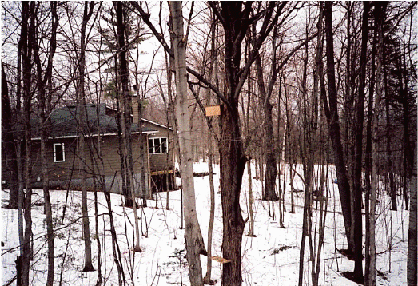
Your baby squirrels will have bonded to you as their main caregiver, and to the place where they have been housed in their pre-release cage for the last four weeks before release. They should therefore be released on your property near where they have been raised, where you can monitor their post-release integration into the wide world. This will increase the likelihood they will stay at their release site and thus improve their chances of survival. However, if that is not possible (your property is unsuitable or neighbours are trapping or harming squirrels), they will need to be placed with another willing caregiver who has a suitable property, with a shed or garage to house their pre-release caging. The placement would need to be for at least three weeks before their release so they can become accustomed to the new site, and their new caregivers. If necessary the squirrels can be kept an extra couple of weeks to accomplish this.
Check the forecast to be sure there will be 2-3 days of dry weather after the squirrels are released and then, just prior to release, remove the nest box they have been using. You can provide a temporary cardboard version or several towels for them to hide under overnight or on the morning of release. Clean the box and remove any cloth bedding since it would become a damp mouldy liability once the box is exposed outside in the tree. Then securely attach the box as high as you can in a tree, at least 12-15 feet up (see photo).
Their familiar nest box will provide shelter and security for them after they are released. On the morning of release day, carry the cage to the base of the tree where the nest box is mounted, and open the door as close to the trunk as possible, using the tree to keep the door wedged open. Bring a lawn chair out and monitor from a little distance. It may take an hour or more before they venture out – but if you position the cage well and let them come out on their own, they will jump onto the tree and spend time exploring it and checking out their nest box.
This is the day all your efforts to raise healthy, alert, strong youngsters has lead to, and hopefully it will be as joyful for you as it usually is for them.
For spring youngsters, released in the summer, provide food and water for at least 4 weeks post-release. For those released in the fall, please continue to feed all winter since they will not have had the time to collect and store food for the winter. Some squirrels will disappear for several days or even a week or two when they are first released, as they explore their new world. Be sure to continue to stock their feeding station every day even if you do not see them since they need your support. A good staple to provide post-release is large, striped, unsalted sunflower seeds. You can also give some hard shell nuts like almonds, pecans, hazelnuts or walnuts as treats, since the youngsters can bury them and have a back-up supply of food. One way to make sure they have fresh water (until they scout out their own source) is to nail a yoghurt container onto the truck of the tree holding their nest box, low enough for you to refill it daily. Provide their food within sight but some distance from the nest box however since you do not want to attract other animals to their box.
Since transitional care is required, the squirrels must be released on private property, where caregivers they recognize are present.
FOR EASTERN GREY SQUIRRELS BASED ON EXPERIENCE OF WILDLIFE REHABILITATORS IN THE NORTHERN UNITED STATES AND CANADA
There is a geographic difference in size for Eastern grey squirrels in North America. Body mass increases as you go further north, so young born in the north will likely be bigger on average than those born further south – although features of each age (for example time when eyes open, or teeth erupt) will be the same. This chart is based on the experience of wildlife rehabilitators at the northern edge of Eastern grey squirrel habitat. Some internet sites indicate a baby Eastern grey squirrel will weight 13-18 grams at birth and about 90 grams when its eyes open at 4 weeks of age – whereas the experience of rehabilitators further north found that young just opening their eyes averaged 120-135 grams, and newborns weighed 20-25 grams in the birth to 1 week age range. Weights for young at the same stage of development will thus vary not only between individuals but across regions as well. Therefore it is best to decide how much formula to feed based on individual weights using this chart as a general guide only.
FOR RED SQUIRRELS BASED ON EXPERIENCE OF WILDLIFE REHABILITATORS IN THE NORTHERN UNITED STATES AND CANADA
Weights for young at the same stage of development will vary not only between individuals but across regions as well. Therefore it is best to decide how much formula to feed based on individual weights using this chart as a general guide only.
*In some jurisdictions it is illegal to care for wildlife and you should consult your government wildlife agency.
1. Photos of Eastern grey squirrel babies from birth to release age, to help you age your orphan, are posted by a Connecticut wildlife rehabilitator at:http://www.squirrelsandmore.com/feature/174/how-to-determine-the-age-of-a-baby-squirrel.htm
This same site has more care information at: http://www.squirrelsandmore.com/feature/166/basic-steps-to-hand-rearing-a-baby-squirrel.htm
Note that the recommendation on this site to try to save severely debilitated/emaciated baby squirrels by using a human convalescence liquid meal (“Ensure”) is meant only until the baby is no longer in a critical condition. “Ensure” can not replace proper formula over the longer term and the baby will need formula as soon as it is able to digest it. Unless the baby you have rescued is severely emaciated, rehydration with Pedialyte followed by gradual introduction of Esbilac puppy formula (followed by Fox Valley squirrel formula when it arrives) will be what is needed.
2. A photo of a 4-5 week old Eastern grey baby squirrel being fed from a 3cc syringe with what looks like an elongated PetAg nipple attached (note how its little forepaws grasp the syringe), can be found at: http://bestpicsaround.com/pic-615-Raising-a-Baby-Squirrel#nav-holder
A photo of a 4-5 week old Red baby squirrel (note the dark stripe on its nose) being fed from a 3cc syringe with a similar nipple can be found at: http://shanalogic.com/wordpress/?tag=animal-rescue
3. A squirrel rehabilitation manual published by the NWRA, written by a Georgia wildlife rehabilitator can be found at:
4. Photos of one rescuer’s experience with tiny eyes-closed Eastern grey baby squirrels – including the attempt to reunite them with their mother can be found at: http://www.paulstravelpictures.com/Orphan-Baby-Squirrel-Care/index.html
5. On-line sources of supplies for raising baby squirrels:
Fox Valley Animal Nutrition milk replacement formula for wildlife can be ordered at: http://foxvalleynutrition.com/main/home.asp
Mazuri rodent blocks for rats and mice can be ordered from several online sites, two such sites are: http://petsmart.com/prodcut/index.jsp?productId=2754059 http://www.squirrelsandmore.com
Rodent blocks made specifically for squirrels can be ordered at: http://www.healthyblocks.com/.html
Small white “Plastic Syringe Tips” or adaptors that will fit a 10cc syringe so that it will hold an elongated nipple can be ordered at: http://store.birdiebitsnbites.com/catalog/index.php?cPath=68 69
6 There is also a “squirrel board” group on the Internet that discusses care of orphaned and injured squirrels at: http://thesquirrelboard.com/forums/index.php
7. Lastly, the following are links to photos and information about Eastern grey squirrels (showing both grey and black phases) and Red squirrels by the Fletcher Wildlife Garden in Ontario, Canada: http://www.ofnc.ca/fletcher/our_animals/squirrels/grey-squirrels_e.php http://www.ofnc.ca/fletcher/our_animals/squirrels/red-squirrels_e.php
|
Page visits since March 14, 2003.
Web counter provided by http://www.digits.com
